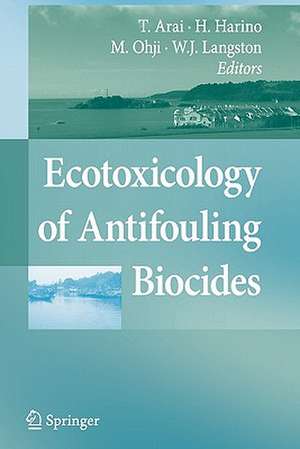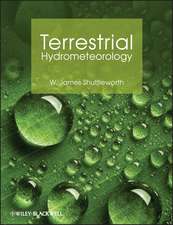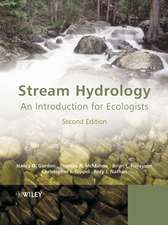Ecotoxicology of Antifouling Biocides
Editat de Takaomi Arai, Hiroya Harino, Madoka Ohji, William Langstonen Limba Engleză Paperback – 21 oct 2010
| Toate formatele și edițiile | Preț | Express |
|---|---|---|
| Paperback (1) | 936.02 lei 6-8 săpt. | |
| Springer – 21 oct 2010 | 936.02 lei 6-8 săpt. | |
| Hardback (1) | 943.02 lei 6-8 săpt. | |
| Springer – 17 feb 2009 | 943.02 lei 6-8 săpt. |
Preț: 936.02 lei
Preț vechi: 1141.50 lei
-18% Nou
Puncte Express: 1404
Preț estimativ în valută:
179.19€ • 184.29$ • 148.66£
179.19€ • 184.29$ • 148.66£
Carte tipărită la comandă
Livrare economică 15 februarie-01 martie
Preluare comenzi: 021 569.72.76
Specificații
ISBN-13: 9784431998556
ISBN-10: 4431998551
Pagini: 456
Ilustrații: XVII, 437 p.
Dimensiuni: 155 x 235 x 24 mm
Greutate: 0.64 kg
Ediția:Softcover reprint of hardcover 1st ed. 2009
Editura: Springer
Colecția Springer
Locul publicării:Tokyo, Japan
ISBN-10: 4431998551
Pagini: 456
Ilustrații: XVII, 437 p.
Dimensiuni: 155 x 235 x 24 mm
Greutate: 0.64 kg
Ediția:Softcover reprint of hardcover 1st ed. 2009
Editura: Springer
Colecția Springer
Locul publicării:Tokyo, Japan
Public țintă
ResearchCuprins
Overview of Antifouling Biocides.- Release Rate of Biocides from Antifouling Paints.- International Trends in Regulatory Aspects.- Behavior of Organotin Compounds and Their Effects on Aquatic Organisms.- Global Contamination by Organotin Compounds.- Contamination by Organotin Compounds in Asia.- Behaviour of Organotins in the Coastal Environment.- Organotin Contamination in Deep Sea Environments.- Mechanism of Imposex Induced by Organotins in Gastropods.- The Endocrine-Disrupting Effect of Organotin Compounds for Aquatic Organisms.- Toxicity for Aquatic Organisms.- Biological Effects of Tributyltin on the Caprellidea (Crustacea: Amphipoda).- Toxic Interactions Between Tributyltin and Polychlorinated Biphenyls in Aquatic Organisms.- Immunotoxic Effects of Organotin Compounds in Teleost Fish.- Genetic Impacts of Organotin Compounds.- Effects of Organotins on the Drug Metabolizing Enzymes in Fish.- Plankton.- Molluscs.- Fish.- Environmental Chemistry of Alternative Biocides.- The Analysis of Antifouling Paint Biocides in Water, Sediment and Biota.- Europe and USA.- Asia.- Toxicity in Plankton and Fish.- Further Effects of Alternative Biocides on Aquatic Organisms.- Degradation of Alternative Biocides in the Aquatic Environment.- Copper Biocides in the Marine Environment.- General Summary.- Overview.
Recenzii
From the reviews:“This timely, clearly written, and useful book addresses an important topic at the interface between commerce and environmental science. … All chapters are extensively illustrated and well referenced. Summing Up: Recommended. Upper-division undergraduates, graduate students, researchers/faculty, and professionals/practitioners.” (N. W. Hinman, Choice, Vol. 47 (3), November, 2009)
Caracteristici
Written by leading researchers of environmental problems caused by antifouling biocides Includes extensive information concerning the fate and the effect of antifouling biocides Reflects recent advances in understanding of antifouling biocides in the environment, including behavior, toxicity, biological impacts, bioaccumulation, and regulation Provides readers with great insight into the chemistry and fate of these compounds in aquatic systems Includes supplementary material: sn.pub/extras





